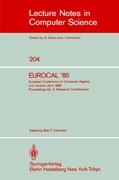- Start
- EUROCAL '85. European Conference on Computer Algebra. Linz, Austria, April 1-3, 1985. Proceedings
EUROCAL '85. European Conference on Computer Algebra. Linz, Austria, April 1-3, 1985. Proceedings
Angebote / Angebote:
Algorithms for polynomial division.- Sparse hensel lifting.- Heugcd: How elementary upperbounds generate cheaper data.- Gaussian elimination over a euclidean ring.- Demonstration of reduce3 as implemented on a stand-alone Motorola 68000 based microcomputer.- The Scratchpad II computer algebra language and system.- The SAC-2 computer algebra system.- DOE-MACSYMA: Progress report.- Towards practical implementations of syllogistic.- Path resolution and semantic graphs.- Fast subsumption algorithms.- Substitution expressions: Extracting solutions of non-Horn clause proofs.- The complexity of elementary problems in archimedean ordered groups.- Progress on the equivalence problem.- Symbol representations of noncommutative algebras.- Algebraic computations in elementary catastrophe theory.- Bifurcation theory and computer algebra: An initial approach.- Factorization of polynomials by transcendental evaluation.- Factorization of rational polynomials in the Zassenhaus ¿ Norm.- On decomposable and commuting polynomials.- Fast polynomial decomposition algorithms.- A program system for root finding.- A program system for factorization of polynomials with rational coefficients.- THKLISP as a base of formula manipulation systems.- AMP a system for algebraic computations.- The program ortocartan for applications in Einstein's relativity theory.- Sheep and classification in general relativity.- Norcan ¿ A computer calculus program.- Demo of stensor.- Visual environments for symbolic computation.- Syntactic equivalences inducing semantic equivalences.- The Algos computational system.- Retrieval in a module library using formal specifications: Preliminary search using syntactic properties.- The J-Machine: Functional programming with combinators.- Symbolic algebra in problems of nonlinear mechanics.- Macsyma's computation of dirac-bergmann algorithm for Hamiltonian syytems with constraints.- Infinite dimensional computer Lie algebra ?.- Application of computer algebra to the theory of the vibration-rotational spectra of diatomic molecules.- Algorithms for the character theory of the symmetric group.- Worst-case analysis of algorithms for computational problems on abelian permutation groups.- A completion of some coxeter groups.- A CAYLEY file of finite simple groups.- On some laws in PSL(2, q).- An adjacency algorithm for cylindrical algebraic decompositions of three-dimensional space.- A cluster-based cylindrical algebraic decomposition algorithm.- On mechanical quantifier elimination for elementary algebra and geometry: Solution of a nontrivial problem.- Gr¿bner bases using SAC2.- A polynomial-time algorithm for the topological type of a real algebraic curve.- An improved projection operation for cylindrical algebraic decomposition.- Arithmetic in quadratic fields with unique factorization.- About a new method for computing in algebraic number fields.- An algebraic implementation of packages.- The SMP pattern matcher.- An expression compression package for REDUCE based on factorization and controlled expansion.- STENSOR uses disc automatically for very large computations.- Numerical methods with automatic verification.- ACRITH ¿ High accuracy arithmetic subroutine library.- Floating-point computation in PASCAL-SC with verified results.- PASCAL-SC demonstration accurate arithmetic for verified results.- A solution to the polynomial hensel-code conversion problem.- A posteriori interval analysis.- Symbolic manipulations on a computer and their application to generation and investigation of difference schemes.- Completeness in data type specifications.- On solving the equality problem in theories defined by Horn clauses.- Reducing the complexity of the Knuth-Bendix completion algorithm: A "unification" of different approaches.- A confluence criterion based on the generalised Newman Lemma.- ERIL ¿ Equational reasoning: an interactive laboratory.- Implementation of a general completion procedure parameterized by built-in theories and strategies.- Computer algebra in Norway.- Goppa codes: Algorithmic problems.- Gcd's and factoring multivariate polynomials using Grobner bases.- A note on the complexity of constructing standard bases.- Some algorithmic questions on ideals of differential operators.- Obtaining complete sets of reductions and equations without using special unification algorithms.- An overview of completion algorithms.- The optimisation by "code motion" of user programs for an algebraic manipulation system.- An improved plotting package for VAXIMA.- On logic programs with data-driven computations.- Darwin, a system designed for the study of enumerative combinatorics.- Correctness proofs of the implementation of abstract data types.- Using prolog for constructing geometric objects defined by constraints.- The role of symbolic computation in the management of scientific information.- CIM (computer integrated manufacturing) ¿ A challenge for symbolic computation.- Symbolic and algebraic computation may support secondary education.- Software toolkit for input stage measurement in symbolic compuation.- The algebraic manipulation systems on the electrical power systems.- A new method of computing fundamental units in algebraic number fields.- The generalized Voronoi-algorithm in totally real algebraic number fields.- An algorithm for the computation of perfect polyhedral cones over real quadratic number fields.- Explicit determination of non-trivial torsion structures of elliptic curves over quadratic number fields.- p-Adic algorithms and the computation of zeros of p-adic l-functions.- On the solution of the diophantine equation Gn=pz.- Term orderings on the polynomial ring.- An algorithmic approach to local rings.- A reduction strategy for the taylor resolution.- From polynomials to Galois groups.- A system for parallel computer algebra programs.- Unification in parallel with refined linearity test: An example of recursive network structure in FP2, a functional parallel programming language.- The parallel L-machine for symbolic computation.- Unification in conditional-equational theories.- Mechanical translation of set theoretic problem specifications into efficient RAM code ¿ A case study.- A methodology for automatic programming based on the constructive matching strategy.- The structural synthesis of programs: New means.- Taking advantage of symmetry in the automatic generation of numerical programs for finite element analysis.- Automatic generation of optimized programs.- Canonical form for rational exponential expressions.- Elementary and Liouvillian solutions of linear differential equations.- Analytical decoupling, decision of compatibility and partial integration of systems of nonlinear ordinary and partial differential equations.- Symbolic integration of exponential polynomials.- A REDUCE package for determining first integrals of autonomous systems of ordinary differential equations.- A package of tools for manipulation of sums and series.- Theory of summation in finite terms.- Abstract of the manuscript entitled "symbol manipulation and symmetry breaking".- On improving approximate results of Buchberger's algorithm by Newton's method.
Folgt in ca. 5 Arbeitstagen
